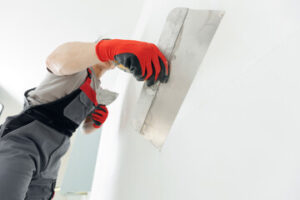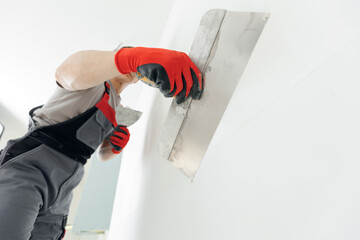Drywall Repair is one of the most satisfying DIY projects for homeowners. It’s relatively quick, inexpensive, and requires minimal experience to get great results. Small dents and nail holes are the most common types of drywall damage. These can usually be fixed by filling the indentation with spackle, smoothing it, and lightly sanding it. For professional expertise, consult Drywall Repair Las Vegas.
 When cracks appear, you must first determine the source. Some are caused by moisture in the walls, which softens and deteriorates the drywall, leading to hairline cracks. Others result from a house’s foundation sinking into wet clay soil or movement in the framing or structural supports.
When cracks appear, you must first determine the source. Some are caused by moisture in the walls, which softens and deteriorates the drywall, leading to hairline cracks. Others result from a house’s foundation sinking into wet clay soil or movement in the framing or structural supports.
If a crack is narrow and limited to the edges of one or more pieces of drywall, you can fill it in with joint compound (also known as drywall mud). Apply a thin layer with a putty knife designed specifically for repairing drywall — not the kind of wide utility knife you would use on wood, as this will mar the surface. Smooth the mud until it’s flush with the wall, then let it dry completely before applying paint.
A crack that extends across a larger section of the wall, or even to the ceiling, is more serious and may indicate a shift in your home’s foundation or structural components. It’s a good idea to bring in a professional to evaluate your foundation and determine the cause of the problem.
The outside corners of drywall are protected from damage by an L-shaped metal strip called corner bead, which is nailed over the corner and concealed by two or more layers of joint compound. However, the corners aren’t indestructible and can become dingy or even dented over time due to many activities, including washing, painting and cleaning the room. If the corner bead is dingy, you can remove it by pulling up the drywall and gently prying the corner away from the frame.
If the corner bead is dented, you can hammer in a small dowel about 3 inches long, then nail the dowel to the frame of the wall, and then apply more joint compound around the hole. A re-taping of the corner is also a good idea, following the techniques described above. Be sure to use a fine-grit sanding sponge to make a crisp corner that will be less likely to get knocked loose again over the years. If the damage is extensive, replacing the drywall might be necessary.
Holes
If you have a hole in the wall, it’s important to address it right away because, besides being unsightly, it could serve as an entry point for unwanted critters. Also, if it’s not repaired quickly, it can allow water to leak behind the wall or become a gathering spot for mold.
Small holes are quick and easy to fix with a drywall patch kit and joint compound. However, if you have medium or large holes, the process can be more complicated. Generally, it will require a larger section of drywall to be cut out and reinstalled. This is why it’s important to consider the scope of the damage when calculating how much your project will cost.
To avoid cutting into any pipes or wires, you’ll need to locate the studs before beginning a repair. Using a stud finder (many of them come with an AC detector as well), mark at least an inch above and below the hole, so you don’t accidentally hit anything when you’re cutting.
Next, carefully cut into the damaged area of drywall with a drywall saw until you get to the studs. Once you’ve done this, take a drywall square and draw lines around the shape of your hole. This will help you cut a larger piece of drywall to replace the old one without hitting any electrical cords or plumbing pipes.
Before applying your drywall patch, sand the surrounding area of the hole with some rough sandpaper to remove the paint and make it easier for the mud or plaster to stick. Then, spread a thin layer of mud or plaster (we recommend getting a drywall patch kit that comes with everything you need) over the entire area.
Small holes can be covered with a self-adhering fiberglass mesh patch, or, if the drywall is still in good condition, you can use a new sheet of drywall to fill the hole. For medium and large holes, you’ll need to screw wood boards into the back of the drywall on either side of the hole. This will prevent the replacement drywall section from collapsing into the hole.
Shifting Foundations
Your foundation is responsible for supporting every aspect of your home, including floors and walls. When a foundation shifts, these structures will also shift, which can lead to floor and wall gaps that are unsightly, uncomfortable, and potentially dangerous. If you see a door that’s difficult to open and close or you notice gaps between the ceiling and crown molding, these are telltale signs that your foundation is shifting.
A professional foundation repair contractor can examine your foundation and drywall to determine the cause of these issues and provide you with a permanent solution. A pier and beam solution may be needed to raise your house further away from the shifting soils or a drainage solution could help move water away from your foundation.
Although drywall is one of the most durable building materials, it’s not very flexible or forgiving. Cracks in drywall are common and can be caused by many factors. Small drywall cracks caused by nail holes and other minor damage can usually be patched with a quick DIY project using a simple repair kit. Larger drywall cracks can be more serious and indicate that your house’s foundation has been damaged. If you have large cracks in drywall that appear to be getting worse, it’s best to call a foundation repair expert as soon as possible.
Drywall cracks may also develop because of changes in the soil moisture content and temperature. Water that accumulates around your foundation during rainy seasons and temperature fluctuations can cause building materials to expand and contract, which eventually causes stress inside the walls. This is especially common for houses built on loose clay soil like in the area.
Foundation repair will prevent drywall cracks from continuing to worsen and can save your home’s structural integrity. Attempting to fix drywall cracks that are the result of serious foundation damage by yourself will only serve as a temporary fix and cost you more money in the long run.
Structural Issues
Drywall performs multiple functions in your home, including keeping weather, pests and debris out of indoor spaces. However, drywall can be damaged in a variety of ways, and damage should be repaired as soon as possible to prevent further problems.
Holes in drywall are usually easy to repair. A patch can be cut to size and plastered over, with a little sanding and re-painting, making the damage virtually invisible. Cracks in drywall are more problematic. These can lead to structural damage in your home and should be assessed by a professional to determine how serious the issue is. Wide cracks that form in walls can signal foundation issues that should be addressed by a foundation specialist as quickly as possible.
When two sheets of drywall meet at an outside wall corner, they’re protected by an L-shaped metal strip called a corner bead. These bead strips are nailed to the corners of the drywall and then concealed with layers of joint compound. These corners are especially vulnerable to dents from run-ins with your vacuum cleaner or careless rearranging of furniture in the room.
Changes in temperature and humidity can cause drywall to expand and contract, causing cracks at the seams. Several studies have shown that acclimating building materials to their environment before installing them can minimize this problem.
Even if your house is newer, settling can cause large gaps and cracks in your drywall. These can be due to a weak foundation, or because the soil underneath your house has shifted and no longer supports your structure. In either case, this type of settling is not good for your home and should be addressed as soon as you notice the problems.
A cracked drywall can also indicate a plumbing leak that needs to be fixed as soon as possible. If left untreated, this problem can cause mold, mildew and other dangerous substances to grow in your drywall. Remediation of toxic mold can be very expensive, and can affect the health and safety of your family. It is important to have these problems assessed and repaired immediately by a reputable drywall company.
